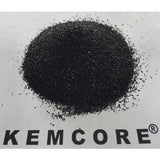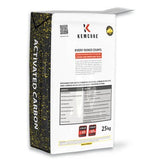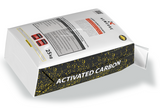Activated carbon CTC 60: 6x12mesh
We supply industry-leading activated carbon products for a wide range of oil, gas, and mining applications. Activated carbon can be used to adsorb gold-cyanide complex in carbon-in-pulp (CIP)/carbon-in-leach (CIL) systems or in columns after a heap leach operation (carbon-in-column systems).
WHAT KEMCORE PROVIDES AS A PARTNER?
Reliable Supply
KEMCORE is always prepared to fulfill orders as they're placed and deliver the product customers need.
Commitment to Safety
KEMCORE has been safely and responsibly distributing Activated Carbon for decades and continues to make advancements through improved packaging options, on-site unloading services, and comprehensive training for our customers.
Dedicated Support
Whether it’s assisting with Activated Carbon handling or regulatory needs like licensing, permitting, and compliance monitoring, support is available.
COUNTRIES OF ORIGIN
- Philippines
- India
CARBON SELECTION GUIDE
The issue with Carbon for all applications be they industrial or mining is that it is sector dependent and most people rely on industry experience. There is no scientific basis on which you can clearly use it as a basis for carbon selection. I will speak from a mining perspective and will probably repeat what you will find everywhere. Carbon used is generally derived from coconut shells and the main basis for selection in Africa in general is:
- Availability, price, and product support. This is key because generally all carbon made has the same technical specifications.
- Hardness/Attrition losses. This can be tested in house using bottle roll tests to establish carbon losses over a time span...in general however despite preferences there is not much difference between suppliers because industry best practice has been adopted the world over in manufacturing.
- Surface area, - very important in gold adsorption. The other parameters are standard and more of repeating what you will find on all the brochures you get (so I will not get into that). The issue is Carbon selection is more of a qualitative rather than quantitative approach and in the process, there also is no substitute for experience and QC. Essentially it's about the manufacturer's name more than anything else and your response to complaints in the event that you have supplied a product that has quality flaws that happen.
Our Coconut-based steam activated carbon is manufactured specifically for gold recovery.
Activated carbon application process flow.
Pregnant gold solutions are passed through activated carbon, where the gold is adsorbed on carbon.
We supply several grades of activated carbon for improved gold recovery. We pride ourselves in ensuring the following carbon properties are enjoyed by our clients:
- Our carbon is coconut shell-based giving it low susceptibility to attrition because of its hardness.
- It has excellent activity making gold adsorption easy
- We also offer activated carbon in several size fractions which gives an array of properties that can suit any particular process.
- With good carbon management practices, our activated carbon has proven to have a longer life in the circuit. This is attributed to its ease of regeneration, hardness even under severe CIP conditions as well as maintenance of high levels of activity.
Carbon loading varies from 300g/ton to as much as 20 000g of gold/ton of carbon
There are several grades of activated carbon, but for gold processing, E612 and E816 are the most commonly used.
The main sizes of activated carbon for gold processing are given in the table below:
Form |
Mean Particle Size (mm) |
Size Fraction (US sieve no.) |
Raw Material |
Granular |
2.5 |
6*12 |
Coconut Shell |
Granular |
2.1 |
6*16 |
Coconut Shell |
Granular |
1.7 |
8*16 |
Coconut Shell |
There are 3 main methods of adsorbing gold on activated carbon in gold leaching:
- Carbon-in-leach (CIL) – in CIL, leaching and CIP are integrated into a single process. Gold is thus adsorbed on the carbon almost as soon as it is dissolved in cyanide. CIL is the preferred method where there are preg-robbing elements in the ore that would otherwise compete for gold with carbon. The activated carbon has to have high activity to adsorb the gold before any other competing carbon forms do so.
- Carbon-in-Pulp (CIP) – in CIP, there are several agitated tanks where NaCN, lime, and oxygen are added to dissolve the gold. The carbon is placed in inter-stage screens and moves counter current to the flow of pulp through the tanks.
- Carbon-in-Column (CIC) – in these solution flows through a series of fluidized beds which can process solution with as low as 2% solids. CIC is mainly used to recover gold from heap leach circuits.
The 3 size fractions in the table above all have individual advantages and disadvantages.
Generally because of increased surface area, the smaller the size fraction, the higher the gold loading capacity. Inter-stage screen management in CIP especially because of the high attrition forces the carbon is exposed to is very important. Large size fractions are recommended to ensure one never losses gold through the screens. Of the three sizes above 6*12 would thus be recommended in CIP and to an extent CIL.
8*16 can be safely used in plants employing CIC.
Factors Affecting Adsorption rate
- Fouling – this is the contamination of activated carbon during use. Major foulants are some flotation reagents, greases used to oil agitators or mills
- Time of contact – the longer this is the more efficient the adsorption
- Temperature – rate increases slightly with temperature, with slightly slower rates likely to be experienced in cold seasons
- Pulp density – the rate of adsorption decreases with increasing slurry density. However, suspension of carbon is difficult if pulp density is too low
- Gold concentration – rate increases with an increase in gold concentration
Elution
Loaded carbon from CIC, CIL, or CIP is removed and washed before undergoing elution at high temperature and pH. Typical solution concentrations for pressure stripping consist of % NaCN and % NaOH. Elution brings back the gold into solution before it is captured by wire wool in electrowinning cells.
Calcium hypochlorite is widely used for water treatment and as a bleaching agent.
Our Calcium hypochlorite finds use in the processes below:
- Disinfectant of drinking water and swimming pool water – it is a sanitizer highly effective in preventing growth of bacteria, algae and other micro-organisms.
- Ingredient in bleaching powder for bleaching linen
- Used to make household cleaners, weed killers, disinfectant sprays.
- Can be used to treat waste-water effluents for paper mills, tanneries and textile mills
Chlorine is a biocide that kills microorganisms, algae etc. Hypochlorite solutions release chlorine into solution which somehow deactivates micro-organism functions in water bodies.
Dosage rates are dependent on the amount of micro organisms in the water body as well as the level of bleaching that needs to be attained.
|
Identifiers |
|
|
CAS number |
7778-54-3 |
|
ChemSpider |
22912 |
|
EC number |
231-908-7 |
|
RTECS number |
NH3485000 |
|
UN number |
1748 |
|
Properties |
|
|
Molecular formula |
Ca(ClO)2 |
|
Molar mass |
142.98 g/mol |
|
Appearance |
white/gray powder |
|
Density |
2.35 g/cm3 (20 °C) |
|
Melting point |
100 °C (212 °F; 373 K) |
|
Boiling point |
175 °C (347 °F; 448 K) decomposes |
|
Solubility in water |
21 g/100 mL, reacts |
|
Solubility |
reacts in alcohol |
|
Identifiers |
|
|
CAS number |
7778-54-3 |
|
ChemSpider |
22912 |
|
EC number |
231-908-7 |
|
RTECS number |
NH3485000 |
|
UN number |
1748 |
|
Properties |
|
|
Molecular formula |
Ca(ClO)2 |
|
Molar mass |
142.98 g/mol |
|
Appearance |
white/gray powder |
|
Density |
2.35 g/cm3 (20 °C) |
|
Melting point |
100 °C (212 °F; 373 K) |
|
Boiling point |
175 °C (347 °F; 448 K) decomposes |
|
Solubility in water |
21 g/100 mL, reacts |
|
Solubility |
reacts in alcohol |








